SpringBlue Dicks
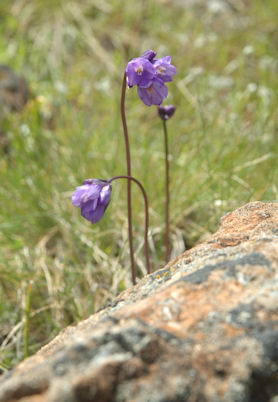 We found these Blue Dicks around the lower ring of rocks on the north side of Azalea Hill in early April. If you tease open the flower you should find six stamens with anthers, three large and three small. If it only has three stamens with anthers it is likely an Ookow. Now don't get excited; no plant was killed for the detail to the right, maimed yes, but a later check revealed all was well. A single flower was removed from the inflorescence. This was also true for the Ookow detailed below in Late Spring.
We found these Blue Dicks around the lower ring of rocks on the north side of Azalea Hill in early April. If you tease open the flower you should find six stamens with anthers, three large and three small. If it only has three stamens with anthers it is likely an Ookow. Now don't get excited; no plant was killed for the detail to the right, maimed yes, but a later check revealed all was well. A single flower was removed from the inflorescence. This was also true for the Ookow detailed below in Late Spring. 
Family: Liliaceae
Scientific Name: Dichelostemma capitatum ssp. capitatum
Calflora
Hooker's Fairybell
 We (Jeanne actually) noticed this lily while we were photographing the Fat Solomon across the road. It was mid-April and if we hadn't been stopped at that spot we probably would have trucked on by and missed it; the flowers are greenish and the foliage blended with the surrounding plants. This Fairybell was on the west side of the lake on the uphill side of the perimeter road just below the lagunitas road fork.
We (Jeanne actually) noticed this lily while we were photographing the Fat Solomon across the road. It was mid-April and if we hadn't been stopped at that spot we probably would have trucked on by and missed it; the flowers are greenish and the foliage blended with the surrounding plants. This Fairybell was on the west side of the lake on the uphill side of the perimeter road just below the lagunitas road fork.
Family: Liliacae
Scientific Name: Prosartes hookeri
Calflora
Slender Goldfields
 These plants were on Azalea Hill and when I first saw them I thought Goldfields. I didn't collect a flower because I get shy when others are about, so when I got home I couldn't say for sure whether it was Lasthenia californica or L. gracilis. For now I'll rely on the Marin CNPS plant lists that only show L. gracilis on Azalea Hill and in Carson Country. I was lucky to get a photo this sharp because, damn, it was windy!
These plants were on Azalea Hill and when I first saw them I thought Goldfields. I didn't collect a flower because I get shy when others are about, so when I got home I couldn't say for sure whether it was Lasthenia californica or L. gracilis. For now I'll rely on the Marin CNPS plant lists that only show L. gracilis on Azalea Hill and in Carson Country. I was lucky to get a photo this sharp because, damn, it was windy!
Family: Asteraceae
Tribe: Heliantheae
Subtribe: Baeriinae
It gets scary when you need to describe Tribes and Subtribes
Scientific Name: Lasthenia gracilis
Calflora
Western Blue Bird
 The east side of Azalea Hill is pretty grassy and apparently Blue Bird territory. I didn't have a long lens so the photo isn't the best but you don't see these cuties every day. I'm not a bird guy but I think you can see both a male and female on this shrub and we saw them in mid-April. Ok, Ok it's not a wildflower!
The east side of Azalea Hill is pretty grassy and apparently Blue Bird territory. I didn't have a long lens so the photo isn't the best but you don't see these cuties every day. I'm not a bird guy but I think you can see both a male and female on this shrub and we saw them in mid-April. Ok, Ok it's not a wildflower!
Family: Turdidae
Scientific Name: Sialia mexicana
Checkerbloom
 The Common Checkerbloom. I didn't collect this plant and like the Goldfields above relied on the Marin CNPS plant list and Marin Flora; those sources helped me identify which Sidalcea maybe on Azalea Hill. I'll check the leaves more closely next season, but I'm pretty certain it's laciniata.
The Common Checkerbloom. I didn't collect this plant and like the Goldfields above relied on the Marin CNPS plant list and Marin Flora; those sources helped me identify which Sidalcea maybe on Azalea Hill. I'll check the leaves more closely next season, but I'm pretty certain it's laciniata.
Family: Malvaceae
Scientific Name: Sidalcea malviflora ssp. laciniata
Calfora
False Lupine
 I think "False" is kind of harsh. How about something like "I can't believe it's not Lupine."
I think "False" is kind of harsh. How about something like "I can't believe it's not Lupine."
We found this colorful pea gracing meadows about Azalea Hill during the middle of April 2008.
Family: Fabaceae
Scientific Name: Thermopsis californica
Calflora
Sickleleaf Onion
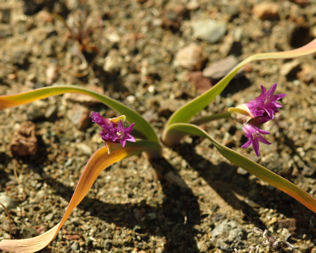
 This wasn't the allium that inspired liver and onions, but you might give it a chance. The flower is pretty once you get down low enough. I don't mean to disrespect this plant, as a matter of fact it is one of the toughest we have come across in Sky Oaks. It grows straight out of hardened, graveled soil with no other wildflowers around it. Azalea Hill mid-April.
This wasn't the allium that inspired liver and onions, but you might give it a chance. The flower is pretty once you get down low enough. I don't mean to disrespect this plant, as a matter of fact it is one of the toughest we have come across in Sky Oaks. It grows straight out of hardened, graveled soil with no other wildflowers around it. Azalea Hill mid-April.
Family: Liliaceae
Scientific Name: Allium falcifolium
Calflora
Scarlet Pimpernel
 OK, right off the bat we need to acknowledge that this is not a native Marin species; we found this one on Azalea Hill among the rocks near the top in mid-April. We must recognize, however, that it is the only ubiquitous flowering Marin plant sharing a name with a dated but famous play written by a baroness named Emmuska Orczy.
OK, right off the bat we need to acknowledge that this is not a native Marin species; we found this one on Azalea Hill among the rocks near the top in mid-April. We must recognize, however, that it is the only ubiquitous flowering Marin plant sharing a name with a dated but famous play written by a baroness named Emmuska Orczy.
Family: Primulaceae
Scientific Name: Anagallis arvensis
Calflora
Purple Sanicle

I don't know. Azalea Hill is essentially Fairfax so I can't be surprized that the usually yellow sanicle is purple up there. Well! I haven't seen it anywhere else yet.
Family: Apiaceae
Scientific Name: Sanicula bipinnatifida
Calflora
Leptosiphon

I suspect everyone has a number of wildflowers they look forward to seeing each year, and for me this is one. I particularly enjoy the swooning stigmas and bright anthers against the white petals. Azalea Hill in latish April.
Family: Polemoniaceae
Scientific Name: Leptosiphon androsaceus
Calflora
Popcorn Flower

Well here we have another white flower that is saved from mediocrity by an interesting little detail. This time a cute tiny little bagel in the center of the corolla. You find the Popcorn Flower throughout Sky Oaks. We found this one on Azalea Hill in late April 2009.
Family: Boraginaceae
Scientific Name: Plagiobothrys nothofulvus
Calflora
Hill Morning Glory
 This Calystegia isn't a delicate climber but instead a tough low growing plant that can thrive in an exposed, windy and rocky enviroment. This Morning Glory was found the same day as the Allium above.
This Calystegia isn't a delicate climber but instead a tough low growing plant that can thrive in an exposed, windy and rocky enviroment. This Morning Glory was found the same day as the Allium above.
Family: Convolvulaceae
Scientific Name: Calystegia collina
Calflora
Owl's Clover

Some don't give a hoot about this clover, but how can you not love those eyes. We found this plant along the road up to Azalea Hill at the end of April.
Family: Orobanchaceae (Scrophulariaceae; See Indian Paint Brush below)
Scientific Name: Castilleja densiflora ssp. densiflora
Calflora
Yerba Santa

 We found this wonderful plant among the lower ring of rocks on the top of Azalea Hill at the end of April.
We found this wonderful plant among the lower ring of rocks on the top of Azalea Hill at the end of April.
Family: Hydrophyllaceae
Scientific Name: Eriodictyon californica
Calflora
Modesty
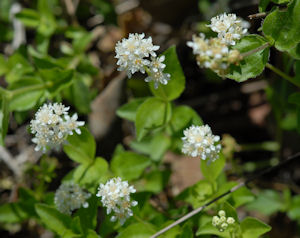 It took me awhile to figure this one out. I tried to key it with Marin Flora, but kept going in the wrong direction. I finally found it in Reny Parker's book: Wildflowers and backtracked in Marin Flora to verify. We saw it for weeks, if not months, usually along the uphill side of the road around Lake Lagunitas. Look for it April into May.
It took me awhile to figure this one out. I tried to key it with Marin Flora, but kept going in the wrong direction. I finally found it in Reny Parker's book: Wildflowers and backtracked in Marin Flora to verify. We saw it for weeks, if not months, usually along the uphill side of the road around Lake Lagunitas. Look for it April into May.
Family: Philadelphaceae
Scientific Name: Whipplea modesta
Calflora
Wood Rose
 You can have Mr. Lincoln and Peace roses in your garden, but they can't compete with the delicate beauty of a Wood Rose in the watershed. We found this plant late in April along the trail around Lake Lagunitas in the wooded areas on the west and south sides. The broader photo on the right was found in mid-May just past the sedum wall.
You can have Mr. Lincoln and Peace roses in your garden, but they can't compete with the delicate beauty of a Wood Rose in the watershed. We found this plant late in April along the trail around Lake Lagunitas in the wooded areas on the west and south sides. The broader photo on the right was found in mid-May just past the sedum wall.
Family: Rosaceae
Scientific Name: Rosa gymnocarpa
Calflora
Douglas Iris
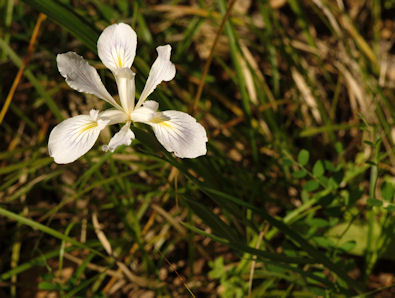 Whether white/cream or blue/purple the Douglas Iris is a common and welcome sight in the Sky Oaks area.
Whether white/cream or blue/purple the Douglas Iris is a common and welcome sight in the Sky Oaks area.
Family: Iridaceae
Scientific Name: Iris douglasiana
Calflora
Indian Paint Brush
 When I was younger and didn't pay attention to things like blooming times, leaf shape and the general look of the flower I would call Indian Warrior(Pedicularis), Indian Paintbrush. I know a little more now, enough to understand that Castilleja is a complicated genus. Fortunately there aren't many different Paintbrushes in Sky Oaks.
When I was younger and didn't pay attention to things like blooming times, leaf shape and the general look of the flower I would call Indian Warrior(Pedicularis), Indian Paintbrush. I know a little more now, enough to understand that Castilleja is a complicated genus. Fortunately there aren't many different Paintbrushes in Sky Oaks.
Family: Orobanchaceae (Late of Scrophulariaceae)
The corporate breakup of the Scrophulariaceae continues in these tumultuous botonical times. Mimulus suffered a hostile taxonomic buyout when Phrymaceae swooped in with strong genetic research. Castilleja met the same fate when leveraged by Orobanchaceae. It's still unknown how many species will be laid-off. We were alerted by Marin Flora, so we wait for Jepson.
Scientific Name: Castilleja affinis var. affinis. I'm more comfortable with: Castilleja sp.
Calflora
Service Berry
 If you walk around Lake Lagunitas three or four times a year you could easily miss this shrub. We found it on the lakeside of the trail in the wooded area before the sedum walls where we would also find Ninebark, Honeysuckle and Cream Bush.
If you walk around Lake Lagunitas three or four times a year you could easily miss this shrub. We found it on the lakeside of the trail in the wooded area before the sedum walls where we would also find Ninebark, Honeysuckle and Cream Bush.

Family: Rosaceae
Scientific Name: Amelanchier utahensis
Calflora
Colchita
 I've always loved this Lotus for both the flower color and shape; they remind me of medieval helmets only yellow with a hint of red. We found these on Azalea Hill at the beginning of May.
I've always loved this Lotus for both the flower color and shape; they remind me of medieval helmets only yellow with a hint of red. We found these on Azalea Hill at the beginning of May.
Family: Fabaceae
Scientific Name: Lotus humistratus
Calflora
Cream Cups
 You will find this sweet flower along the trail around Lagunitas just as you approach the open area of the Sedum walls; it's on the lakeside. If you are just walking along with someone and discussing the recent infidelity suffered by a mutual friend, YOU WILL MISS THIS FLOWER! It's dainty and low to the ground and a very welcome sight in early May.
You will find this sweet flower along the trail around Lagunitas just as you approach the open area of the Sedum walls; it's on the lakeside. If you are just walking along with someone and discussing the recent infidelity suffered by a mutual friend, YOU WILL MISS THIS FLOWER! It's dainty and low to the ground and a very welcome sight in early May.
Family: Papaveraceae
Scientific Name: Platystemon californicus
Calflora
Tomcat Clover
 In 2008 we found this clover blooming near the Cream Cups just a meter, or less, down the slope. A year later we would find it along the access road at the bottom of the sedum wall.
In 2008 we found this clover blooming near the Cream Cups just a meter, or less, down the slope. A year later we would find it along the access road at the bottom of the sedum wall.
Family: Fabaceae
Scientific Name: Trifolium willdenovii
Calflora
Sedum

If you walk around Lake Lagunitas some places stick with you; the dam and spillway, the three bridges and the Sedum Wall all come to mind. The Sedum wall is the uphill rock formation in the open area on the East end of the lake. There are other wildflowers that like to bloom there, but really, it's Sedum turf.

Family: Crassulaceae
Scientific Name: Sedum spathulifolium

Calflora
Starflower
 A delicate sweet plant, low to the ground and easy to overlook were it not for the unique star shape of the flower.
A delicate sweet plant, low to the ground and easy to overlook were it not for the unique star shape of the flower.
Family: Myrsinaceae (Late of the Primulaceae)
Scientific Name: Trientalis latifolia
Calflora
Woodland Star
 This would be just another mousey white flower were it not for its' beautiful shape. There are two species of Woodland Star in Sky Oaks. They can be distinguished by the shape of the bottom of the flower and calyx. A pointed or V-shaped bottom is Lithophragma affine; the U-shaped bottom is Lithophragma heterophyllum. I believe the Star to the left is affine and the one to the right heterophyllum.
This would be just another mousey white flower were it not for its' beautiful shape. There are two species of Woodland Star in Sky Oaks. They can be distinguished by the shape of the bottom of the flower and calyx. A pointed or V-shaped bottom is Lithophragma affine; the U-shaped bottom is Lithophragma heterophyllum. I believe the Star to the left is affine and the one to the right heterophyllum.
Family: Saxifragaceae
Scientific Names:Lithophragma affine and Lithophragma heterophyllum
Calflora: affine
Calflora: heterophyllum
Larkspur
 You know, if you're just a plant you can't help but be proud when those feckless humans actually name a town after you.
You know, if you're just a plant you can't help but be proud when those feckless humans actually name a town after you.
One place to look for this icon is the straightaway before the Sedum wall during the end of April well into May.
Family: Ranunculaceae
Scientific Name: Delphinium patens
Calflora
Hedge Nettle
 This plant is a mint. It has a very pretty weedy character about it, especially the white lower petal spotted with pink/purple. We found it around Lake Lagunitas in mid-May. This plant, like many others, has been in a taxonomic flux but may now be home.
This plant is a mint. It has a very pretty weedy character about it, especially the white lower petal spotted with pink/purple. We found it around Lake Lagunitas in mid-May. This plant, like many others, has been in a taxonomic flux but may now be home.
Family: Laminceae
Scientific Name: Stachys ajugoides var. rigida
Calflora
Cream-Sacs
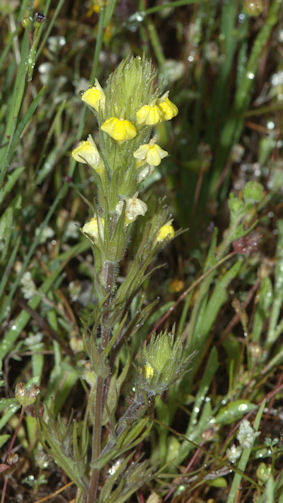 Jeanne and I have have been up to Azalea Hill more often recently and came across plants we hadn't seen before. 2010 was unusual with cool rainy weather that went well into Spring. This Cream-Sac was plentiful in mid to late May on much of this eastern Carson-country site.
Jeanne and I have have been up to Azalea Hill more often recently and came across plants we hadn't seen before. 2010 was unusual with cool rainy weather that went well into Spring. This Cream-Sac was plentiful in mid to late May on much of this eastern Carson-country site.
Family: Orobanchaceae (Late of the Scrophulariaceae).
Scientific Name: Castilleja rubicundula ssp. lithospermoides
Calflora
Jewelflower
 Oh,Oh how I wish I had taken a finger and flicked the moisture off of that young plant to the left for a sharper picture. It was beautiful and dramatic as it began to bloom. The mature (different) plant to the right was less ordered, but still pretty. We found both plants a week apart near the top of Azalea Hill in mid-May.
Oh,Oh how I wish I had taken a finger and flicked the moisture off of that young plant to the left for a sharper picture. It was beautiful and dramatic as it began to bloom. The mature (different) plant to the right was less ordered, but still pretty. We found both plants a week apart near the top of Azalea Hill in mid-May.
Mustard, really.
Family: Brassicaceae
Scientific Name: Streptanthus glandulosus ssp. secundus
Calflora
Late SpringHome
Comments and Corrections
 We found these Blue Dicks around the lower ring of rocks on the north side of Azalea Hill in early April. If you tease open the flower you should find six stamens with anthers, three large and three small. If it only has three stamens with anthers it is likely an Ookow. Now don't get excited; no plant was killed for the detail to the right, maimed yes, but a later check revealed all was well. A single flower was removed from the inflorescence. This was also true for the Ookow detailed below in Late Spring.
We found these Blue Dicks around the lower ring of rocks on the north side of Azalea Hill in early April. If you tease open the flower you should find six stamens with anthers, three large and three small. If it only has three stamens with anthers it is likely an Ookow. Now don't get excited; no plant was killed for the detail to the right, maimed yes, but a later check revealed all was well. A single flower was removed from the inflorescence. This was also true for the Ookow detailed below in Late Spring. 



 The east side of Azalea Hill is pretty grassy and apparently Blue Bird territory. I didn't have a long lens so the photo isn't the best but you don't see these cuties every day. I'm not a bird guy but I think you can see both a male and female on this shrub and we saw them in mid-April. Ok, Ok it's not a wildflower!
The east side of Azalea Hill is pretty grassy and apparently Blue Bird territory. I didn't have a long lens so the photo isn't the best but you don't see these cuties every day. I'm not a bird guy but I think you can see both a male and female on this shrub and we saw them in mid-April. Ok, Ok it's not a wildflower! The Common Checkerbloom. I didn't collect this plant and like the Goldfields above relied on the Marin CNPS plant list and Marin Flora; those sources helped me identify which Sidalcea maybe on Azalea Hill. I'll check the leaves more closely next season, but I'm pretty certain it's laciniata.
The Common Checkerbloom. I didn't collect this plant and like the Goldfields above relied on the Marin CNPS plant list and Marin Flora; those sources helped me identify which Sidalcea maybe on Azalea Hill. I'll check the leaves more closely next season, but I'm pretty certain it's laciniata.































 Oh,Oh how I wish I had taken a finger and flicked the moisture off of that young plant to the left for a sharper picture. It was beautiful and dramatic as it began to bloom. The mature (different) plant to the right was less ordered, but still pretty. We found both plants a week apart near the top of Azalea Hill in mid-May.
Oh,Oh how I wish I had taken a finger and flicked the moisture off of that young plant to the left for a sharper picture. It was beautiful and dramatic as it began to bloom. The mature (different) plant to the right was less ordered, but still pretty. We found both plants a week apart near the top of Azalea Hill in mid-May.